Polymer
| Polymer science |
|---|
 |
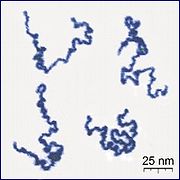
A polymer is a substance composed of macromolecules.[2]A macromolecule is a molecule of high relative molecular mass, the structure of which essentially comprises the multiple repetition of units derived, actually or conceptually, from molecules of low relative molecular mass.[3]
Apolymer(/ˈpɒlɪmər/[4][5]) is asubstanceormaterialconsisting ofvery large moleculeslinked together into chains ofrepeating subunits.[6]Due to their broad spectrum of properties,[7]both synthetic and natural polymers play essential and ubiquitous roles in everyday life.[8]Polymers range from familiarsynthetic plasticssuch aspolystyreneto naturalbiopolymerssuch asDNAandproteinsthat are fundamental to biological structure and function. Polymers, both natural and synthetic, are created viapolymerizationof many small molecules, known asmonomers.Their consequently largemolecular mass,relative tosmall moleculecompounds,produces uniquephysical propertiesincludingtoughness,highelasticity,viscoelasticity,and a tendency to formamorphousandsemicrystallinestructures rather thancrystals.
Polymers are studied in the fields ofpolymer science(which includespolymer chemistryandpolymer physics),biophysicsandmaterials science and engineering.Historically, products arising from the linkage of repeating units bycovalentchemical bondshave been the primary focus of polymer science. An emerging important area now focuses onsupramolecular polymersformed by non-covalent links.Polyisopreneoflatexrubberis an example of a natural polymer, and thepolystyreneofstyrofoamis an example of a synthetic polymer. In biological contexts, essentially all biologicalmacromolecules—i.e., proteins (polyamides),nucleic acids(polynucleotides), andpolysaccharides—are purely polymeric, or are composed in large part of polymeric components.

Etymology
The term "polymer" derives fromGreekπολύς(polus)'many, much', andμέρος(meros)'part'. The term was coined in 1833 byJöns Jacob Berzelius,thoughwith a definitiondistinct from the modernIUPACdefinition.[9][10]The modern concept of polymers as covalently bonded macromolecular structures was proposed in 1920 byHermann Staudinger,[11]who spent the next decade finding experimental evidence for this hypothesis.[12]
Common examples
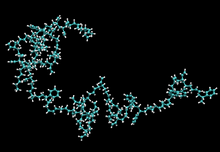
Polymers are of two types: naturally occurring and synthetic orman made.
Natural
Natural polymeric materialssuch ashemp,shellac,amber,wool,silk,and naturalrubberhave been used for centuries. A variety of other natural polymers exist, such ascellulose,which is the main constituent of wood and paper.
Space polymer
Hemoglycin(previously termedhemolithin) is a space polymer that is the first polymer ofamino acidsfound inmeteorites.[13][14][15]
Synthetic
Thelist of synthetic polymers,roughly in order of worldwide demand, includespolyethylene,polypropylene,polystyrene,polyvinyl chloride,synthetic rubber,phenol formaldehyde resin(orBakelite),neoprene,nylon,polyacrylonitrile,PVB,silicone,and many more. More than 330 million tons of these polymers are made every year (2015).[16]
Most commonly, the continuously linked backbone of a polymer used for the preparation of plastics consists mainly ofcarbonatoms. A simple example is polyethylene ('polythene' in British English), whose repeat unit or monomer isethylene.Many other structures do exist; for example, elements such as silicon form familiar materials such as silicones, examples beingSilly Puttyand waterproof plumbing sealant.Oxygenis also commonly present in polymer backbones, such as those ofpolyethylene glycol,polysaccharides(inglycosidic bonds), andDNA(inphosphodiester bonds).
Synthesis
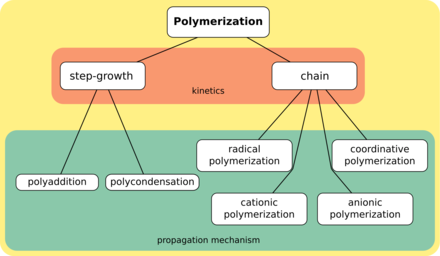
Polymerization is the process of combining manysmall moleculesknown as monomers into a covalently bonded chain or network. During the polymerization process, some chemical groups may be lost from each monomer. This happens in the polymerization ofPET polyester.The monomers areterephthalic acid(HOOC—C6H4—COOH) andethylene glycol(HO—CH2—CH2—OH) but the repeating unit is —OC—C6H4—COO—CH2—CH2—O—, which corresponds to the combination of the two monomers with the loss of two water molecules. The distinct piece of each monomer that is incorporated into the polymer is known as arepeat unitor monomer residue.
Synthetic methods are generally divided into two categories,step-growth polymerizationandchain polymerization.[17]The essential difference between the two is that in chain polymerization, monomers are added to the chain one at a time only,[18]such as inpolystyrene,whereas in step-growth polymerization chains of monomers may combine with one another directly,[19]such as inpolyester.Step-growth polymerization can be divided intopolycondensation,in which low-molar-mass by-product is formed in every reaction step, andpolyaddition.

Newer methods, such asplasma polymerizationdo not fit neatly into either category. Synthetic polymerization reactions may be carried out with or without acatalyst.Laboratory synthesis of biopolymers, especially ofproteins,is an area of intensive research.
Biological synthesis

There are three main classes of biopolymers:polysaccharides,polypeptides,andpolynucleotides. In living cells, they may be synthesized by enzyme-mediated processes, such as the formation of DNA catalyzed byDNA polymerase.Thesynthesis of proteinsinvolves multiple enzyme-mediated processes totranscribegenetic information from the DNA toRNAand subsequentlytranslatethat information to synthesize the specified protein fromamino acids.The protein may bemodified furtherfollowing translation in order to provide appropriate structure and functioning. There are other biopolymers such asrubber,suberin,melanin,andlignin.
Modification of natural polymers
Naturally occurring polymers such ascotton,starch,and rubber were familiar materials for years before synthetic polymers such aspolyetheneandperspexappeared on the market. Many commercially important polymers are synthesized by chemical modification of naturally occurring polymers. Prominent examples include the reaction ofnitric acidandcelluloseto formnitrocelluloseand the formation ofvulcanized rubberby heating natural rubber in the presence ofsulfur.Ways in which polymers can be modified includeoxidation,cross-linking,andend-capping.
Structure
The structure of a polymeric material can be described at different length scales, from the sub-nm length scale up to the macroscopic one. There is in fact a hierarchy of structures, in which each stage provides the foundations for the next one.[20] The starting point for the description of the structure of a polymer is the identity of its constituent monomers. Next, themicrostructureessentially describes the arrangement of these monomers within the polymer at the scale of a single chain. The microstructure determines the possibility for the polymer to form phases with different arrangements, for example throughcrystallization,theglass transitionormicrophase separation.[21] These features play a major role in determining the physical and chemical properties of a polymer.
Monomers and repeat units
The identity of the repeat units (monomer residues, also known as "mers" ) comprising a polymer is its first and most important attribute. Polymer nomenclature is generally based upon the type of monomer residues comprising the polymer. A polymer which contains only a single type ofrepeat unitis known as ahomopolymer,while a polymer containing two or more types of repeat units is known as acopolymer.[22]Aterpolymeris a copolymer which contains three types of repeat units.[23]
Polystyreneis composed only ofstyrene-based repeat units, and is classified as a homopolymer.Polyethylene terephthalate,even though produced from two differentmonomers(ethylene glycolandterephthalic acid), is usually regarded as a homopolymer because only one type of repeat unit is formed.Ethylene-vinyl acetatecontains more than one variety of repeat unit and is a copolymer. Some biological polymers are composed of a variety of different but structurally related monomer residues; for example,polynucleotidessuch as DNA are composed of four types ofnucleotidesubunits.
Homopolymers and copolymers (examples) 



Homopolymerpolystyrene Homopolymerpolydimethylsiloxane,asilicone.The main chain is formed of silicon and oxygen atoms. The homopolymerpolyethylene terephthalatehas only onerepeat unit. Copolymerstyrene-butadiene rubber:The repeat units based onstyreneand1,3-butadieneform two repeating units, which can alternate in any order in the macromolecule, making the polymer thus a random copolymer.
A polymer containing ionizable subunits (e.g., pendantcarboxylic groups) is known as apolyelectrolyteorionomer,when the fraction of ionizable units is large or small respectively.
Microstructure
The microstructure of a polymer (sometimes called configuration) relates to the physical arrangement of monomer residues along the backbone of the chain.[24]These are the elements of polymer structure that require the breaking of a covalent bond in order to change. Various polymer structures can be produced depending on the monomers and reaction conditions: A polymer may consist of linear macromolecules containing each only one unbranched chain. In the case of unbranched polyethylene, this chain is a long-chainn-alkane. There are also branched macromolecules with a main chain and side chains, in the case of polyethylene the side chains would bealkyl groups.In particular unbranched macromolecules can be in the solid state semi-crystalline, crystalline chain sections highlighted red in the figure below.
While branched and unbranched polymers are usually thermoplastics, manyelastomershave a wide-meshed cross-linking between the "main chains". Close-meshed crosslinking, on the other hand, leads tothermosets.Cross-links and branches are shown as red dots in the figures. Highly branched polymers are amorphous and the molecules in the solid interact randomly.

Linear, unbranched macromolecule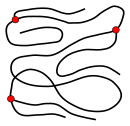
Branched macromolecule
Semi-crystalline structure of an unbranched polymer
Slightlycross-linkedpolymer (elastomer)
Highly cross-linked polymer (thermoset)
Polymer architecture

An important microstructural feature of a polymer is its architecture and shape, which relates to the way branch points lead to a deviation from a simple linear chain.[25]Abranched polymermolecule is composed of a main chain with one or more substituent side chains or branches. Types of branched polymers includestar polymers,comb polymers,polymer brushes,dendronized polymers,ladder polymers,anddendrimers.[25]There exist alsotwo-dimensional polymers(2DP) which are composed of topologically planar repeat units. A polymer's architecture affects many of its physical properties including solution viscosity, melt viscosity, solubility in various solvents,glass-transitiontemperature and the size of individual polymer coils in solution. A variety of techniques may be employed for the synthesis of a polymeric material with a range of architectures, for exampleliving polymerization.
Chain length
A common means of expressing the length of a chain is thedegree of polymerization,which quantifies the number of monomers incorporated into the chain.[26][27]As with other molecules, a polymer's size may also be expressed in terms ofmolecular weight.Since synthetic polymerization techniques typically yield a statistical distribution of chain lengths, the molecular weight is expressed in terms of weighted averages. Thenumber-average molecular weight(Mn) andweight-average molecular weight(Mw) are most commonly reported.[28][29]The ratio of these two values (Mw/Mn) is thedispersity(Đ), which is commonly used to express the width of the molecular weight distribution.[30]
The physical properties[31]of polymer strongly depend on the length (or equivalently, the molecular weight) of the polymer chain.[32]One important example of the physical consequences of the molecular weight is the scaling of theviscosity(resistance to flow) in the melt.[33]The influence of the weight-average molecular weight () on the melt viscosity () depends on whether the polymer is above or below the onset ofentanglements.Below the entanglement molecular weight[clarification needed],,whereas above the entanglement molecular weight,.In the latter case, increasing the polymer chain length 10-fold would increase the viscosity over 1000 times.[34][page needed]Increasing chain length furthermore tends to decrease chain mobility, increase strength and toughness, and increase the glass-transition temperature (Tg).[35]This is a result of the increase in chain interactions such asvan der Waals attractionsandentanglementsthat come with increased chain length.[36][37]These interactions tend to fix the individual chains more strongly in position and resist deformations and matrix breakup, both at higher stresses and higher temperatures.
Monomer arrangement in copolymers
Copolymers are classified either as statistical copolymers, alternating copolymers, block copolymers, graft copolymers or gradient copolymers. In the schematic figure below,ⒶandⒷsymbolize the tworepeat units.

Random copolymer
Gradient copolymer
Graft copolymer
Alternating copolymer
Block copolymer
- Alternating copolymerspossess two regularly alternating monomer residues:[38](AB)
n.An example is the equimolar copolymer ofstyreneandmaleic anhydrideformed by free-radical chain-growth polymerization.[39]A step-growth copolymer such asNylon 66can also be considered a strictly alternating copolymer of diamine and diacid residues, but is often described as a homopolymer with the dimeric residue of one amine and one acid as a repeat unit.[40] - Periodic copolymershave more than two species of monomer units in a regular sequence.[41]
- Statistical copolymershave monomer residues arranged according to a statistical rule. A statistical copolymer in which the probability of finding a particular type of monomer residue at a particular point in the chain is independent of the types of surrounding monomer residue may be referred to as a trulyrandom copolymer.[42][43]For example, the chain-growth copolymer ofvinyl chlorideandvinyl acetateis random.[39]
- Block copolymershave long sequences of different monomer units.[39][40]Polymers with two or three blocks of two distinct chemical species (e.g., A and B) are called diblock copolymers and triblock copolymers, respectively. Polymers with three blocks, each of a different chemical species (e.g., A, B, and C) are termed triblock terpolymers.
- Graft or grafted copolymerscontain side chains or branches whose repeat units have a different composition or configuration than the main chain.[40]The branches are added on to a preformed main chain macromolecule.[39]
Monomers within a copolymer may be organized along the backbone in a variety of ways. A copolymer containing a controlled arrangement of monomers is called asequence-controlled polymer.[44]Alternating, periodic and block copolymers are simple examples ofsequence-controlled polymers.
Tacticity
Tacticity describes the relativestereochemistryofchiralcenters in neighboring structural units within a macromolecule. There are three types of tacticity:isotactic(all substituents on the same side),atactic(random placement of substituents), andsyndiotactic(alternating placement of substituents).
Morphology
Polymer morphology generally describes the arrangement and microscale ordering of polymer chains in space. The macroscopic physical properties of a polymer are related to the interactions between the polymer chains.
 Randomly oriented polymer |
 Interlocking of several polymers |
- Disordered polymers:In the solid state, atactic polymers, polymers with a high degree ofbranchingand random copolymers formamorphous(i.e. glassy structures).[45]In melt and solution, polymers tend to form a constantly changing "statistical cluster", seefreely-jointed-chain model.In thesolid state,the respectiveconformationsof the molecules are frozen. Hooking and entanglement of chain molecules lead to a "mechanical bond" between the chains.Intermolecularand intramolecular attractive forces only occur at sites where molecule segments are close enough to each other. The irregular structures of the molecules prevent a narrower arrangement.
 Polyethylene: zigzag conformation of molecules in close packed chains |
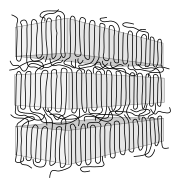 Lamella with tie molecules |
 Spherulite |
 polypropylenehelix |
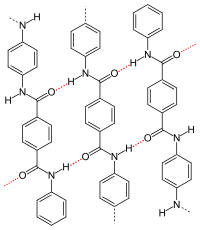 p-Aramid,red dotted: hydrogen bonds |
- Linear polymerswith periodic structure, low branching and stereoregularity (e. g. not atactic) have asemi-crystallinestructure in the solid state.[45]In simple polymers (such as polyethylene), the chains are present in the crystal in zigzag conformation. Several zigzag conformations form dense chain packs, called crystallites or lamellae. The lamellae are much thinner than the polymers are long (often about 10 nm).[46]They are formed by more or less regular folding of one or more molecular chains. Amorphous structures exist between the lamellae. Individual molecules can lead to entanglements between the lamellae and can also be involved in the formation of two (or more) lamellae (chains than called tie molecules). Several lamellae form a superstructure, aspherulite,often with a diameter in the range of 0.05 to 1 mm.[46]
- The type and arrangement of (functional) residues of the repeat units effects or determines the crystallinity and strength of the secondary valence bonds. In isotactic polypropylene, the molecules form a helix. Like the zigzag conformation, such helices allow a dense chain packing. Particularly strong intermolecular interactions occur when the residues of the repeating units allow the formation ofhydrogen bonds,as in the case ofp-aramid.The formation of strong intramolecular associations may produce diverse folded states of single linear chains with distinctcircuit topology.Crystallinity and superstructure are always dependent on the conditions of their formation, see also:crystallization of polymers.Compared to amorphous structures, semi-crystalline structures lead to a higher stiffness, density, melting temperature and higher resistance of a polymer.
- Cross-linked polymers:Wide-meshed cross-linked polymers areelastomersand cannot be molten (unlikethermoplastics); heating cross-linked polymers only leads todecomposition.Thermoplastic elastomers,on the other hand, are reversibly "physically crosslinked" and can be molten. Block copolymers in which a hard segment of the polymer has a tendency to crystallize and a soft segment has an amorphous structure are one type of thermoplastic elastomers: the hard segments ensure wide-meshed, physical crosslinking.
 Wide-meshed cross-linked polymer (elastomer) |
 Wide-meshed cross-linked polymer (elastomer) undertensile stress |
 Crystallitesas "crosslinking sites": one type ofthermoplastic elastomer |
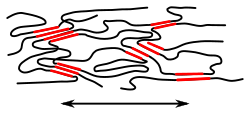 Semi-crystalline thermoplastic elastomer under tensile stress |
Crystallinity
When applied to polymers, the termcrystallinehas a somewhat ambiguous usage. In some cases, the termcrystallinefinds identical usage to that used in conventionalcrystallography.For example, the structure of a crystalline protein or polynucleotide, such as a sample prepared forx-ray crystallography,may be defined in terms of a conventional unit cell composed of one or more polymer molecules with cell dimensions of hundreds ofangstromsor more. A synthetic polymer may be loosely described as crystalline if it contains regions of three-dimensional ordering on atomic (rather than macromolecular) length scales, usually arising from intramolecular folding or stacking of adjacent chains. Synthetic polymers may consist of both crystalline and amorphous regions; the degree of crystallinity may be expressed in terms of a weight fraction or volume fraction of crystalline material. Few synthetic polymers are entirely crystalline.[47]The crystallinity of polymers is characterized by their degree of crystallinity, ranging from zero for a completely non-crystalline polymer to one for a theoretical completely crystalline polymer. Polymers with microcrystalline regions are generally tougher (can be bent more without breaking) and more impact-resistant than totally amorphous polymers.[48]Polymers with a degree of crystallinity approaching zero or one will tend to be transparent, while polymers with intermediate degrees of crystallinity will tend to be opaque due to light scattering by crystalline or glassy regions. For many polymers, crystallinity may also be associated with decreased transparency.
Chain conformation
The space occupied by a polymer molecule is generally expressed in terms ofradius of gyration,which is an average distance from the center of mass of the chain to the chain itself. Alternatively, it may be expressed in terms ofpervaded volume,which is the volume spanned by the polymer chain and scales with the cube of the radius of gyration.[49] The simplest theoretical models for polymers in the molten, amorphous state areideal chains.
Properties
Polymer properties depend of their structure and they are divided into classes according to their physical bases. Many physical and chemical properties describe how a polymer behaves as a continuous macroscopic material. They are classified as bulk properties, orintensive propertiesaccording tothermodynamics.
Mechanical properties

The bulk properties of a polymer are those most often of end-use interest. These are the properties that dictate how the polymer actually behaves on a macroscopic scale.
Tensile strength
Thetensile strengthof a material quantifies how much elongating stress the material will endure before failure.[50][51]This is very important in applications that rely upon a polymer's physical strength or durability. For example, a rubber band with a higher tensile strength will hold a greater weight before snapping. In general, tensile strength increases with polymer chain length andcrosslinkingof polymer chains.
Young's modulus of elasticity
Young's modulusquantifies theelasticityof the polymer. It is defined, for smallstrains,as the ratio of rate of change of stress to strain. Like tensile strength, this is highly relevant in polymer applications involving the physical properties of polymers, such as rubber bands. The modulus is strongly dependent on temperature.Viscoelasticitydescribes a complex time-dependent elastic response, which will exhibithysteresisin the stress-strain curve when the load is removed.Dynamic mechanical analysisor DMA measures this complex modulus by oscillating the load and measuring the resulting strain as a function of time.
Transport properties
Transport propertiessuch asdiffusivitydescribe how rapidly molecules move through the polymer matrix. These are very important in many applications of polymers for films and membranes.
The movement of individual macromolecules occurs by a process calledreptationin which each chain molecule is constrained by entanglements with neighboring chains to move within a virtual tube. The theory of reptation can explain polymer molecule dynamics andviscoelasticity.[52]
Phase behavior
Crystallization and melting
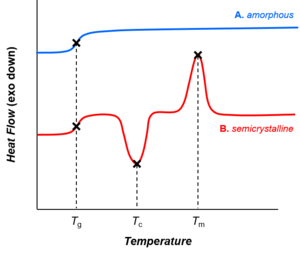
Depending on their chemical structures, polymers may be either semi-crystalline or amorphous. Semi-crystalline polymers can undergocrystallization and melting transitions,whereas amorphous polymers do not. In polymers, crystallization and melting do not suggest solid-liquid phase transitions, as in the case of water or other molecular fluids. Instead, crystallization and melting refer to the phase transitions between two solid states (i.e.,semi-crystalline and amorphous). Crystallization occurs above the glass-transition temperature (Tg) and below the melting temperature (Tm).
Glass transition
All polymers (amorphous or semi-crystalline) go throughglass transitions.The glass-transition temperature (Tg) is a crucial physical parameter for polymer manufacturing, processing, and use. BelowTg,molecular motions are frozen and polymers are brittle and glassy. AboveTg,molecular motions are activated and polymers are rubbery and viscous. The glass-transition temperature may be engineered by altering the degree of branching or crosslinking in the polymer or by the addition ofplasticizers.[53]
Whereas crystallization and melting are first-orderphase transitions,the glass transition is not.[54]The glass transition shares features of second-order phase transitions (such as discontinuity in the heat capacity, as shown in the figure), but it is generally not considered a thermodynamic transition between equilibrium states.
Mi xing behavior

In general, polymeric mixtures are far lessmisciblethan mixtures ofsmall moleculematerials. This effect results from the fact that the driving force for mi xing is usuallyentropy,not interaction energy. In other words, miscible materials usually form a solution not because their interaction with each other is more favorable than their self-interaction, but because of an increase in entropy and hence free energy associated with increasing the amount of volume available to each component. This increase in entropy scales with the number of particles (or moles) being mixed. Since polymeric molecules are much larger and hence generally have much higher specific volumes than small molecules, the number of molecules involved in a polymeric mixture is far smaller than the number in a small molecule mixture of equal volume. The energetics of mi xing, on the other hand, is comparable on a per volume basis for polymeric and small molecule mixtures. This tends to increase the free energy of mi xing for polymer solutions and thereby making solvation less favorable, and thereby making the availability of concentrated solutions of polymers far rarer than those of small molecules.
Furthermore, the phase behavior of polymer solutions and mixtures is more complex than that of small molecule mixtures. Whereas most small molecule solutions exhibit only anupper critical solution temperaturephase transition (UCST), at which phase separation occurs with cooling, polymer mixtures commonly exhibit alower critical solution temperaturephase transition (LCST), at which phase separation occurs with heating.
In dilute solutions, the properties of the polymer are characterized by the interaction between the solvent and the polymer. In a good solvent, the polymer appears swollen and occupies a large volume. In this scenario, intermolecular forces between the solvent and monomer subunits dominate over intramolecular interactions. In a bad solvent or poor solvent, intramolecular forces dominate and the chain contracts. In thetheta solvent,or the state of the polymer solution where the value of the second virial coefficient becomes 0, the intermolecular polymer-solvent repulsion balances exactly the intramolecular monomer-monomer attraction. Under the theta condition (also called theFlorycondition), the polymer behaves like an idealrandom coil.The transition between the states is known as acoil–globule transition.
Inclusion of plasticizers
Inclusion of plasticizers tends to lower Tgand increase polymer flexibility. Addition of the plasticizer will also modify dependence of the glass-transition temperature Tgon the cooling rate.[55]The mobility of the chain can further change if the molecules of plasticizer give rise to hydrogen bonding formation. Plasticizers are generally small molecules that are chemically similar to the polymer and create gaps between polymer chains for greater mobility and fewer interchain interactions. A good example of the action of plasticizers is related to polyvinylchlorides or PVCs. A uPVC, or unplasticized polyvinylchloride, is used for things such as pipes. A pipe has no plasticizers in it, because it needs to remain strong and heat-resistant. Plasticized PVC is used in clothing for a flexible quality. Plasticizers are also put in some types of cling film to make the polymer more flexible.
Chemical properties
The attractive forces between polymer chains play a large part in determining the polymer's properties. Because polymer chains are so long, they have many such interchain interactions per molecule, amplifying the effect of these interactions on the polymer properties in comparison to attractions between conventional molecules. Different side groups on the polymer can lend the polymer toionic bondingorhydrogen bondingbetween its own chains. These stronger forces typically result in higher tensile strength and higher crystalline melting points.
The intermolecular forces in polymers can be affected bydipolesin the monomer units. Polymers containingamideorcarbonylgroups can formhydrogen bondsbetween adjacent chains; the partially positively charged hydrogen atoms in N-H groups of one chain are strongly attracted to the partially negatively charged oxygen atoms in C=O groups on another. These strong hydrogen bonds, for example, result in the high tensile strength and melting point of polymers containingurethaneorurealinkages.Polyestershavedipole-dipole bondingbetween the oxygen atoms in C=O groups and the hydrogen atoms in H-C groups. Dipole bonding is not as strong as hydrogen bonding, so a polyester's melting point and strength are lower thanKevlar's (Twaron), but polyesters have greater flexibility. Polymers with non-polar units such as polyethylene interact only through weakVan der Waals forces.As a result, they typically have lower melting temperatures than other polymers.
When a polymer is dispersed or dissolved in a liquid, such as in commercial products like paints and glues, the chemical properties and molecular interactions influence how the solution flows and can even lead toself-assemblyof the polymer into complex structures. When a polymer is applied as a coating, the chemical properties will influence the adhesion of the coating and how it interacts with external materials, such assuperhydrophobicpolymer coatings leading to water resistance. Overall the chemical properties of a polymer are important elements for designing new polymeric material products.
Optical properties
Polymers such asPMMAand HEMA:MMA are used as matrices in the gain medium ofsolid-state dye lasers,also known as solid-state dye-doped polymer lasers. These polymers have a high surface quality and are also highly transparent so that the laser properties are dominated by thelaser dyeused to dope the polymer matrix. These type of lasers, that also belong to the class oforganic lasers,are known to yield very narrowlinewidthswhich is useful for spectroscopy and analytical applications.[56]An important optical parameter in the polymer used in laser applications is the change in refractive index with temperature also known as dn/dT. For the polymers mentioned here the (dn/dT) ~ −1.4 × 10−4in units of K−1in the 297 ≤ T ≤ 337 K range.[57]
Electrical properties
Most conventional polymers such as polyethylene areelectrical insulators,but the development of polymers containingπ-conjugated bondshas led to a wealth of polymer-basedsemiconductors,such aspolythiophenes.This has led to many applications in the field oforganic electronics.
Applications
Nowadays, synthetic polymers are used in almost all walks of life. Modern society would look very different without them. The spreading of polymer use is connected to their unique properties: low density, low cost, good thermal/electrical insulation properties, high resistance to corrosion, low-energy demanding polymer manufacture and facile processing into final products. For a given application, the properties of a polymer can be tuned or enhanced by combination with other materials, as incomposites.Their application allows to save energy (lighter cars and planes, thermally insulated buildings), protect food and drinking water (packaging), save land and lower use of fertilizers (synthetic fibres), preserve other materials (coatings), protect and save lives (hygiene, medical applications). A representative, non-exhaustive list of applications is given below.
- Clothing, sportswear and accessories:polyesterandPVC clothing,spandex,sport shoes,wetsuits,footballsandbilliard balls,skisandsnowboards,rackets,parachutes,sails,tents and shelters.
- Electronic and photonic technologies: organicfield effect transistors(OFET),light emitting diodes(OLED) andsolar cells,television components,compact discs(CD),photoresists,holography.
- Packaging and containers:films,bottles,food packaging,barrels.
- Insulation:electricalandthermal insulation,spray foams.
- Construction and structural applications:garden furniture,PVCwindows, flooring,sealing,pipes.
- Paints, glues and lubricants:varnish,adhesives,dispersants,anti-graffiti coatings,antifouling coatings,non-stick surfaces,lubricants.
- Car parts:tires,bumpers,windshields,windscreen wipers,fuel tanks,car seats.
- Household items:buckets,kitchenware,toys (e.g.,construction setsandRubik's cube).
- Medical applications:blood bag,syringes,rubber gloves,surgical suture,contact lenses,prosthesis,controlled drug delivery and release,matrices for cell growth.
- Personal hygiene and healthcare:diapersusingsuperabsorbent polymers,toothbrushes,cosmetics,shampoo,condoms.
- Security:personal protective equipment,bulletproof vests,space suits,ropes.
- Separation technologies:synthetic membranes,fuel cell membranes,filtration,ion-exchange resins.
- Money:polymer banknotesandpayment cards.
- 3D printing.
Standardized nomenclature
There are multiple conventions for naming polymer substances. Many commonly used polymers, such as those found in consumer products, are referred to by a common or trivial name. The trivial name is assigned based on historical precedent or popular usage rather than a standardized naming convention. Both theAmerican Chemical Society(ACS)[58]andIUPAC[59]have proposed standardized naming conventions; the ACS and IUPAC conventions are similar but not identical.[60]Examples of the differences between the various naming conventions are given in the table below:
| Common name | ACS name | IUPAC name |
|---|---|---|
| Poly(ethylene oxide)or PEO | Poly(oxyethylene) | Poly(oxyethylene) |
| Poly(ethylene terephthalate)or PET | Poly(oxy-1,2-ethanediyloxycarbonyl-1,4-phenylenecarbonyl) | Poly(oxyethyleneoxyterephthaloyl) |
| Nylon 6or Polyamide 6 | Poly[imino(1-oxo-1,6-hexanediyl)] | Poly[azanediyl(1-oxohexane-1,6-diyl)] |
In both standardized conventions, the polymers' names are intended to reflect the monomer(s) from which they are synthesized (source based nomenclature) rather than the precise nature of the repeating subunit. For example, the polymer synthesized from the simple alkeneetheneis called polyethene, retaining the-enesuffix even though the double bond is removed during the polymerization process:
However, IUPAC structure based nomenclature is based on naming of the preferredconstitutional repeating unit.[61]
Characterization
Polymer characterization spans many techniques for determining the chemical composition, molecular weight distribution, and physical properties. Select common techniques include the following:
- Size-exclusion chromatography(also calledgel permeation chromatography), sometimes coupled withstatic light scattering,can used to determine the number-average molecular weight, weight-average molecular weight, anddispersity.
- Scattering techniques, such asstatic light scatteringandsmall-angle neutron scattering,are used to determine the dimensions (radius of gyration) of macromolecules in solution or in the melt. These techniques are also used to characterize the three-dimensional structure of microphase-separatedblock polymers,polymeric micelles, and other materials.
- Wide-angle X-ray scattering(also called wide-angle X-ray diffraction) is used to determine the crystalline structure of polymers (or lack thereof).
- Spectroscopy techniques, includingFourier-transform infrared spectroscopy,Raman spectroscopy,andnuclear magnetic resonance spectroscopy,can be used to determine the chemical composition.
- Differential scanning calorimetryis used to characterize the thermal properties of polymers, such as the glass-transition temperature, crystallization temperature, and melting temperature. The glass-transition temperature can also be determined bydynamic mechanical analysis.
- Thermogravimetryis a useful technique to evaluate the thermal stability of the polymer.
- Rheologyis used to characterize the flow and deformation behavior. It can be used to determine theviscosity,modulus,and other rheological properties. Rheology is also often used to determine the molecular architecture (molecular weight, molecular weight distribution, branching) and to understand how the polymer can be processed.
Degradation

Polymer degradation is a change in the properties—tensile strength,color,shape, or molecular weight—of a polymer or polymer-based product under the influence of one or more environmental factors, such asheat,light,and the presence of certainchemicals,oxygen, andenzymes.This change in properties is often the result of bond breaking in the polymer backbone (chain scission) which may occur at the chain ends or at random positions in the chain.
Although such changes are frequently undesirable, in some cases, such asbiodegradationandrecycling,they may be intended to prevent environmentalpollution.Degradation can also be useful in biomedical settings. For example, a copolymer ofpolylactic acidandpolyglycolic acidis employed in hydrolysable stitches that slowly degrade after they are applied to a wound.
The susceptibility of a polymer to degradation depends on its structure. Epoxies and chains containing aromatic functionalities are especially susceptible toUV degradationwhile polyesters are susceptible to degradation byhydrolysis.Polymers containing anunsaturatedbackbone degrade viaozone cracking.Carbon based polymers are more susceptible to thermal degradation thaninorganic polymerssuch aspolydimethylsiloxaneand are therefore not ideal for most high-temperature applications.[citation needed]
The degradation of polyethylene occurs by random scission—a random breakage of the bonds that hold theatomsof the polymer together. When heated above 450 °C, polyethylene degrades to form a mixture of hydrocarbons. In the case of chain-end scission, monomers are released and this process is referred to as unzipping ordepolymerization.Which mechanism dominates will depend on the type of polymer and temperature; in general, polymers with no or a single small substituent in the repeat unit will decompose via random-chain scission.
The sorting of polymer waste for recycling purposes may be facilitated by the use of theresin identification codesdeveloped by theSociety of the Plastics Industryto identify the type of plastic.
Product failure
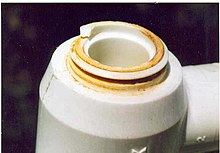
Failure ofsafety-criticalpolymer components can cause serious accidents, such as fire in the case of cracked and degraded polymerfuel lines.Chlorine-induced cracking ofacetal resinplumbing joints andpolybutylenepipes has caused many serious floods in domestic properties, especially in the US in the 1990s. Traces ofchlorinein the water supply attacked polymers present in the plumbing, a problem which occurs faster if any of the parts have been poorlyextrudedorinjection molded.Attack of the acetal joint occurred because of faulty molding, leading to cracking along the threads of the fitting where there isstress concentration.

Polymer oxidation has caused accidents involvingmedical devices.One of the oldest known failure modes is ozone cracking caused by chain scission whenozonegas attacks susceptibleelastomers,such asnatural rubberandnitrile rubber.They possess double bonds in their repeat units which are cleaved duringozonolysis.Cracks in fuel lines can penetrate the bore of the tube and cause fuel leakage. If cracking occurs in the engine compartment, electric sparks can ignite thegasolineand can cause a serious fire. In medical use degradation of polymers can lead to changes of physical and chemical characteristics of implantable devices.[62]
Nylon 66is susceptible toacid hydrolysis,and in one accident, a fractured fuel line led to a spillage of diesel into the road. Ifdiesel fuelleaks onto the road, accidents to following cars can be caused by the slippery nature of the deposit, which is likeblack ice.Furthermore, theasphalt concreteroad surface will suffer damage as a result of the diesel fuel dissolving theasphaltenesfrom the composite material, this resulting in the degradation of the asphalt surface and structural integrity of the road.
History
Polymers have been essential components of commodities since the early days of humankind. The use ofwool(keratin),cottonandlinenfibres (cellulose) for garments,paper reed(cellulose) forpaperare just a few examples of how ancient societies exploited polymer-containing raw materials to obtain artefacts. The latex sap of"caoutchouc" trees(natural rubber) reached Europe in the 16th century from South America long after theOlmec,MayaandAztechad started using it as a material to make balls, waterproof textiles and containers.[63]
The chemical manipulation of polymers dates back to the 19th century, although at the time the nature of these species was not understood. The behaviour of polymers was initially rationalised according to the theory proposed byThomas Grahamwhich considered them as colloidal aggregates of small molecules held together by unknown forces.
Notwithstanding the lack of theoretical knowledge, the potential of polymers to provide innovative, accessible and cheap materials was immediately grasped. The work carried out byBraconnot,Parkes,Ludersdorf,Haywardand many others on the modification of natural polymers determined many significant advances in the field.[64]Their contributions led to the discovery of materials such ascelluloid,galalith,parkesine,rayon,vulcanised rubberand, later,Bakelite:all materials that quickly entered industrial manufacturing processes and reached households as garments components (e.g.,fabrics, buttons), crockery and decorative items.
In 1920,Hermann Staudingerpublished his seminal work "Über Polymerisation",[65]in which he proposed that polymers were in fact long chains of atoms linked by covalent bonds. His work was debated at length, but eventually it was accepted by the scientific community. Because of this work, Staudinger was awarded the Nobel Prize in 1953.[66]
After the 1930s polymers entered a golden age during which new types were discovered and quickly given commercial applications, replacing naturally-sourced materials. This development was fuelled by an industrial sector with a strong economic drive and it was supported by a broad academic community that contributed innovative syntheses of monomers from cheaper raw material, more efficient polymerisation processes, improved techniques for polymer characterisation and advanced, theoretical understanding of polymers.[64]

Since 1953,six Nobel prizeshave been awarded in the area of polymer science, excluding those for research onbiological macromolecules.This further testifies to its impact on modern science and technology. AsLord Toddsummarised in 1980, "I am inclined to think that the development of polymerization is perhaps the biggest thing that chemistry has done, where it has had the biggest effect on everyday life".[68]
See also
- Ideal chain
- Catenation
- Inorganic polymer
- Important publications in polymer chemistry
- Oligomer
- Polymer adsorption
- Polymer classes
- Polymer engineering
- Polymery (botany)
- Reactive compatibilization
- Sequence-controlled polymer
- Shape-memory polymer
- Sol–gel process
- Supramolecular polymer
- Thermoplastic
- Thermosetting polymer
References
- ^Roiter, Y.; Minko, S. (2005). "AFM Single Molecule Experiments at the Solid-Liquid Interface: In Situ Conformation of Adsorbed Flexible Polyelectrolyte Chains".Journal of the American Chemical Society.127(45): 15688–15689.doi:10.1021/ja0558239.PMID16277495.
- ^IUPAC,Compendium of Chemical Terminology,2nd ed. (the "Gold Book" ) (1997). Online corrected version: (2006–) "polymer".doi:10.1351/goldbook.P04735
- ^IUPAC,Compendium of Chemical Terminology,2nd ed. (the "Gold Book" ) (1997). Online corrected version: (2006–) "macromolecule (polymer molecule)".doi:10.1351/goldbook.M03667
- ^"Polymer – Definition of polymer".The Free Dictionary.Retrieved23 July2013.
- ^"Define polymer".Dictionary Reference.Retrieved23 July2013.
- ^"Polymer on Britannica".25 December 2023.
- ^Painter, Paul C.; Coleman, Michael M. (1997).Fundamentals of polymer science: an introductory text.Lancaster, Pa.: Technomic Pub. Co. p. 1.ISBN978-1-56676-559-6.
- ^McCrum, N. G.; Buckley, C. P.; Bucknall, C. B. (1997).Principles of polymer engineering.Oxford; New York: Oxford University Press. p. 1.ISBN978-0-19-856526-0.
- ^If two substances had molecular formulae such that one was an integer multiple of the other – e.g., acetylene (C2H2) and benzene (C6H6) – Berzelius called the multiple formula "polymeric". See: Jöns Jakob Berzelius (1833) "Isomerie,Unterscheidung von damit analogen Verhältnissen "(Isomeric,distinction from relations analogous to it),Jahres-Bericht über die Fortschitte der physischen Wissenschaften…,12:63–67.From page 64:"Um diese Art von Gleichheit in der Zusammensetzung, bei Ungleichheit in den Eigenschaften, bezeichnen zu können, möchte ich für diese Körper die Benennungpolymerische(vonπολυςmehrere) vorschlagen. "(In order to be able to denote this type of similarity in composition [which is accompanied] by differences in properties, I would like to propose the designation" polymeric "(fromπολυς,several) for these substances.)
Originally published in 1832 in Swedish as: Jöns Jacob Berzelius (1832) "Isomeri, dess distinktion från dermed analoga förhållanden,"Årsberättelse om Framstegen i Fysik och Kemi,pages 65–70; the word "polymeriska" appears onpage 66. - ^Jensen, William B.(2008)."Ask the Historian: The origin of the polymer concept"(PDF).Journal of Chemical Education.85(5): 624–625.Bibcode:2008JChEd..85..624J.doi:10.1021/ed085p624.Archived fromthe original(PDF)on 18 June 2018.Retrieved4 March2013.
- ^Staudinger, H (1920)."Über Polymerisation"[On polymerization].Berichte der Deutschen Chemischen Gesellschaft(in German).53(6): 1073–1085.doi:10.1002/cber.19200530627.
- ^Allcock, Harry R.; Lampe, Frederick W.; Mark, James E. (2003).Contemporary Polymer Chemistry(3 ed.). Pearson Education. p. 21.ISBN978-0-13-065056-6.
- ^McGeoch, J.E.M.; McGeoch, M.W. (2015)."Polymer amide in the Allende and Murchison meteorites".Meteoritics & Planetary Science.50(12): 1971–1983.Bibcode:2015M&PS...50.1971M.doi:10.1111/maps.12558.S2CID97089690.
- ^McGeogh, Julie E. M.; McGeogh, Malcolm W. (28 September 2022)."Chiral 480nm absorption in the hemoglycin space polymer: a possible link to replication".Scientific Reports.12(1): 16198.doi:10.1038/s41598-022-21043-4.PMC9519966.PMID36171277.
- ^Staff (29 June 2021)."Polymers in meteorites provide clues to early solar system".Science Digest.Retrieved9 January2023.
- ^"World Plastics Production"(PDF).
- ^Sperling, L. H. (Leslie Howard) (2006).Introduction to physical polymer science.Hoboken, N.J.: Wiley. p. 10.ISBN978-0-471-70606-9.
- ^Sperling, p. 11
- ^Sperling, p. 15
- ^Sperling, p. 29
- ^Bower, David I. (2002).An introduction to polymer physics.Cambridge University Press.ISBN9780511801280.
- ^Rudin, p. 17
- ^Cowie, p. 4
- ^Sperling, p. 30
- ^abRubinstein, Michael; Colby, Ralph H. (2003).Polymer physics.Oxford; New York: Oxford University Press. p.6.ISBN978-0-19-852059-7.
- ^McCrum, p. 30
- ^Rubinstein, p. 3
- ^McCrum, p. 33
- ^Rubinstein, pp. 23–24
- ^Painter, p. 22
- ^De Gennes, Pierre Gilles (1979).Scaling concepts in polymer physics.Ithaca, N.Y.: Cornell University Press.ISBN978-0-8014-1203-5.
- ^Rubinstein, p. 5
- ^McCrum, p. 37
- ^Introduction to Polymer Science and Chemistry: A Problem-Solving Approach By Manas Chanda
- ^O'Driscoll, K.; Amin Sanayei, R. (July 1991). "Chain-length dependence of the glass transition temperature".Macromolecules.24(15): 4479–4480.Bibcode:1991MaMol..24.4479O.doi:10.1021/ma00015a038.
- ^Pokrovskii, V. N. (2010).The Mesoscopic Theory of Polymer Dynamics.Springer Series in Chemical Physics. Vol. 95.Bibcode:2010mtpd.book.....P.doi:10.1007/978-90-481-2231-8.ISBN978-90-481-2230-1.
- ^Edwards, S. F. (1967). "The statistical mechanics of polymerized material".Proceedings of the Physical Society.92(1): 9–16.Bibcode:1967PPS....92....9E.doi:10.1088/0370-1328/92/1/303.
- ^Painter, p. 14
- ^abcdRudin, p. 18–20
- ^abcCowie, p. 104
- ^"Periodic copolymer".IUPAC Compendium of Chemical Terminology, 2nd ed. (the "Gold Book" ).International Union of Pure and Applied Chemistry. 2014.doi:10.1351/goldbook.P04494.Retrieved9 April2020.
- ^Painter, p. 15
- ^Sperling, p. 47
- ^Lutz, Jean-François; Ouchi, Makoto; Liu, David R.; Sawamoto, Mitsuo (9 August 2013). "Sequence-Controlled Polymers".Science.341(6146): 1238149.doi:10.1126/science.1238149.ISSN0036-8075.PMID23929982.S2CID206549042.
- ^abBernd Tieke:Makromolekulare Chemie.3. Auflage, Wiley-VCH, Weinheim 2014, S. 295f (in German).
- ^abWolfgang Kaiser:Kunststoffchemie für Ingenieure.3. Auflage, Carl Hanser, München 2011, S. 84.
- ^Sayed, Abu (August 2014)."Types of polymer: Requirements of fibre forming polymer".Textile Apex.
- ^Allcock, Harry R.; Lampe, Frederick W.; Mark, James E. (2003).Contemporary Polymer Chemistry(3 ed.). Pearson Education. p. 546.ISBN978-0-13-065056-6.
- ^Rubinstein, p. 13
- ^Ashby, Michael;Jones, David (1996).Engineering Materials(2 ed.). Butterworth-Heinermann. pp.191–195.ISBN978-0-7506-2766-5.
- ^Meyers, M. A.; Chawla, K. K. (1999).Mechanical Behavior of Materials.Cambridge University Press. p. 41.ISBN978-0-521-86675-0.Archived fromthe originalon 2 November 2013.Retrieved31 December2018.
- ^Fried, Joel R. (2003).Polymer Science & Technology(2nd ed.). Prentice Hall. pp. 155–6.ISBN0-13-018168-4.
- ^Brandrup, J.; Immergut, E.H.; Grulke, E.A. (1999).Polymer Handbook(4 ed.). Wiley-Interscience.ISBN978-0-471-47936-9.
- ^Meille, S.; Allegra, G.; Geil, P.; et al. (2011)."Definitions of terms relating to crystalline polymers (IUPAC Recommendations 2011)"(PDF).Pure and Applied Chemistry.83(10): 1831–1871.doi:10.1351/PAC-REC-10-11-13.S2CID98823962.Retrieved31 December2018.
- ^Capponi, S.; Alvarez, F.; Racko, D. (2020), "Free Volume in a PVME Polymer–Water Solution",Macromolecules,XXX(XXX): XXX–XXX,Bibcode:2020MaMol..53.4770C,doi:10.1021/acs.macromol.0c00472,hdl:10261/218380,S2CID219911779
- ^Duarte, F. J. (1999). "Multiple-prism grating solid-state dye laser oscillator: optimized architecture".Applied Optics.38(30): 6347–6349.Bibcode:1999ApOpt..38.6347D.doi:10.1364/AO.38.006347.PMID18324163.
- ^Duarte, F. J.(2003).Tunable Laser Optics.New York: Elsevier Academic.ISBN978-0122226960.
- ^CAS: Index Guide, Appendix IV ((c) 1998)
- ^IUPAC (1976)."Nomenclature of Regular Single-Strand Organic Polymers".Pure Appl. Chem.48(3): 373–385.doi:10.1351/pac197648030373.
- ^Wilks, E.S."Macromolecular Nomenclature Note No. 18".Archived fromthe originalon 25 September 2003.
- ^Hiorns, R. C.; Boucher, R. J.; Duhlev, R.; Hellwich, Karl-Heinz; Hodge, Philip; Jenkins, Aubrey D.; Jones, Richard G.; Kahovec, Jaroslav; Moad, Graeme; Ober, C. K.; Smith, D. W. (3 October 2012)."A brief guide to polymer nomenclature (IUPAC Technical Report)".Pure and Applied Chemistry.84(10): 2167–2169.doi:10.1351/PAC-REP-12-03-05.ISSN0033-4545.S2CID95629051.
- ^Iakovlev, V.; Guelcher, S.; Bendavid, R. (28 August 2015). "Degradation of polypropylene in vivo: A microscopic analysis of meshes explanted from patients".Journal of Biomedical Materials Research Part B: Applied Biomaterials.105(2): 237–248.doi:10.1002/jbm.b.33502.PMID26315946.
- ^Hurley, Paul E. (May 1981). "History of Natural Rubber".Journal of Macromolecular Science: Part A - Chemistry.15(7): 1279–1287.doi:10.1080/00222338108056785.ISSN0022-233X.
- ^abFeldman, Dorel (January 2008)."Polymer History".Designed Monomers and Polymers.11(1): 1–15.doi:10.1163/156855508X292383.ISSN1568-5551.S2CID219539020.
- ^Staudinger, H. (12 June 1920)."Über Polymerisation".Berichte der Deutschen Chemischen Gesellschaft (A and B Series).53(6): 1073–1085.doi:10.1002/cber.19200530627.ISSN0365-9488.
- ^"The Nobel Prize in Chemistry 1953".NobelPrize.org.Retrieved25 June2020.
- ^Feldman, Dorel (1 January 2008)."Polymer History".Designed Monomers and Polymers.11(1): 1–15.doi:10.1163/156855508X292383.S2CID219539020.
- ^"Lord Todd: the state of chemistry".Chemical & Engineering News Archive.58(40): 28–33. 6 October 1980.doi:10.1021/cen-v058n040.p028.ISSN0009-2347.
Bibliography
- Cowie, J. M. G. (John McKenzie Grant) (1991).Polymers: chemistry and physics of modern materials.Glasgow: Blackie.ISBN978-0-412-03121-2.
- Hall, Christopher (1989).Polymer materials(PDF)(2nd ed.). London; New York: Macmillan.ISBN978-0-333-46379-6.
- Rudin, Alfred (1982).The elements of polymer science and engineering.Academic Press.ISBN978-0-12-601680-2.
- Wright, David C. (2001).Environmental Stress Cracking of Plastics.RAPRA.ISBN978-1-85957-064-7.
External links
This article'suse ofexternal linksmay not follow Wikipedia's policies or guidelines.(June 2021) |









